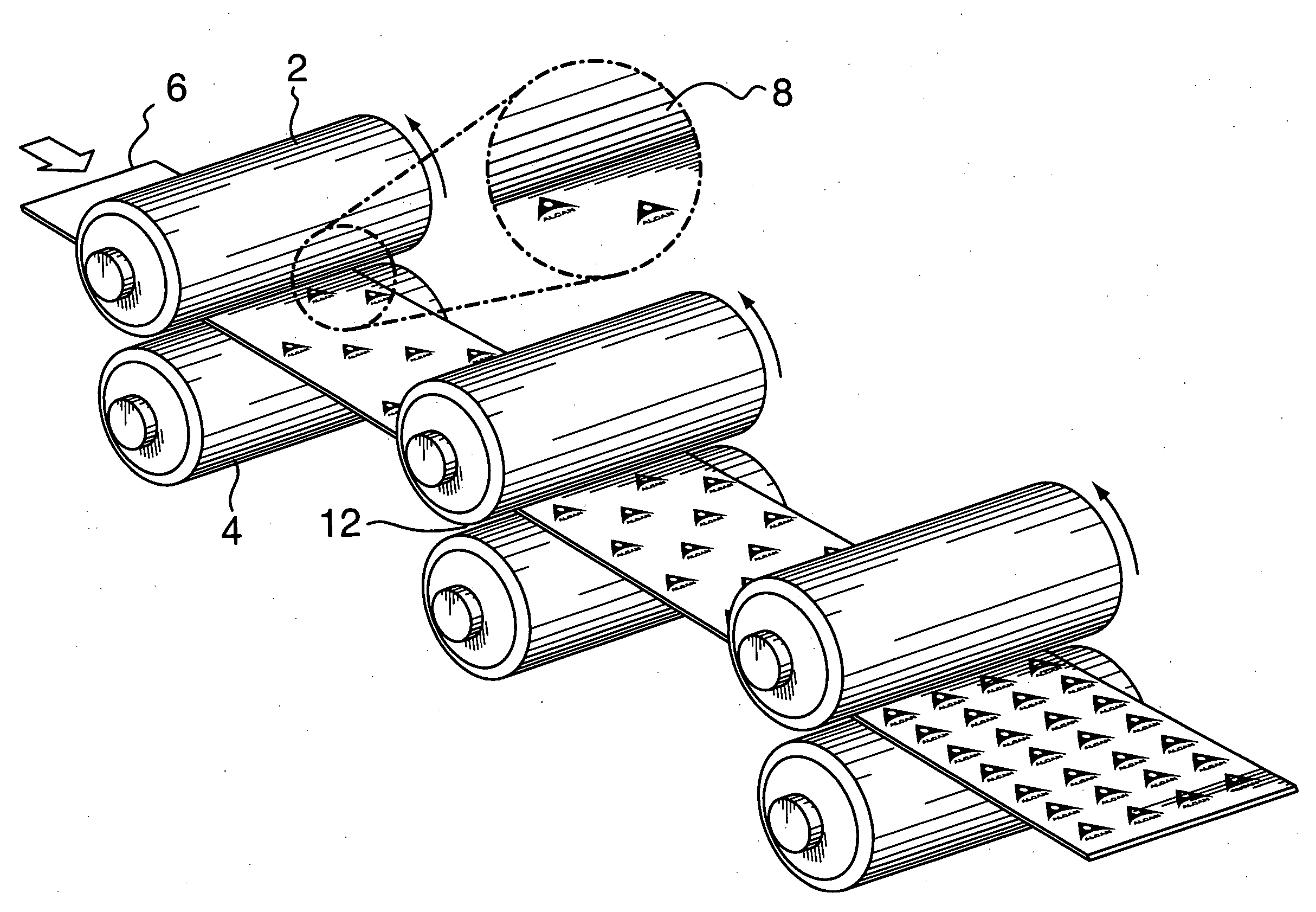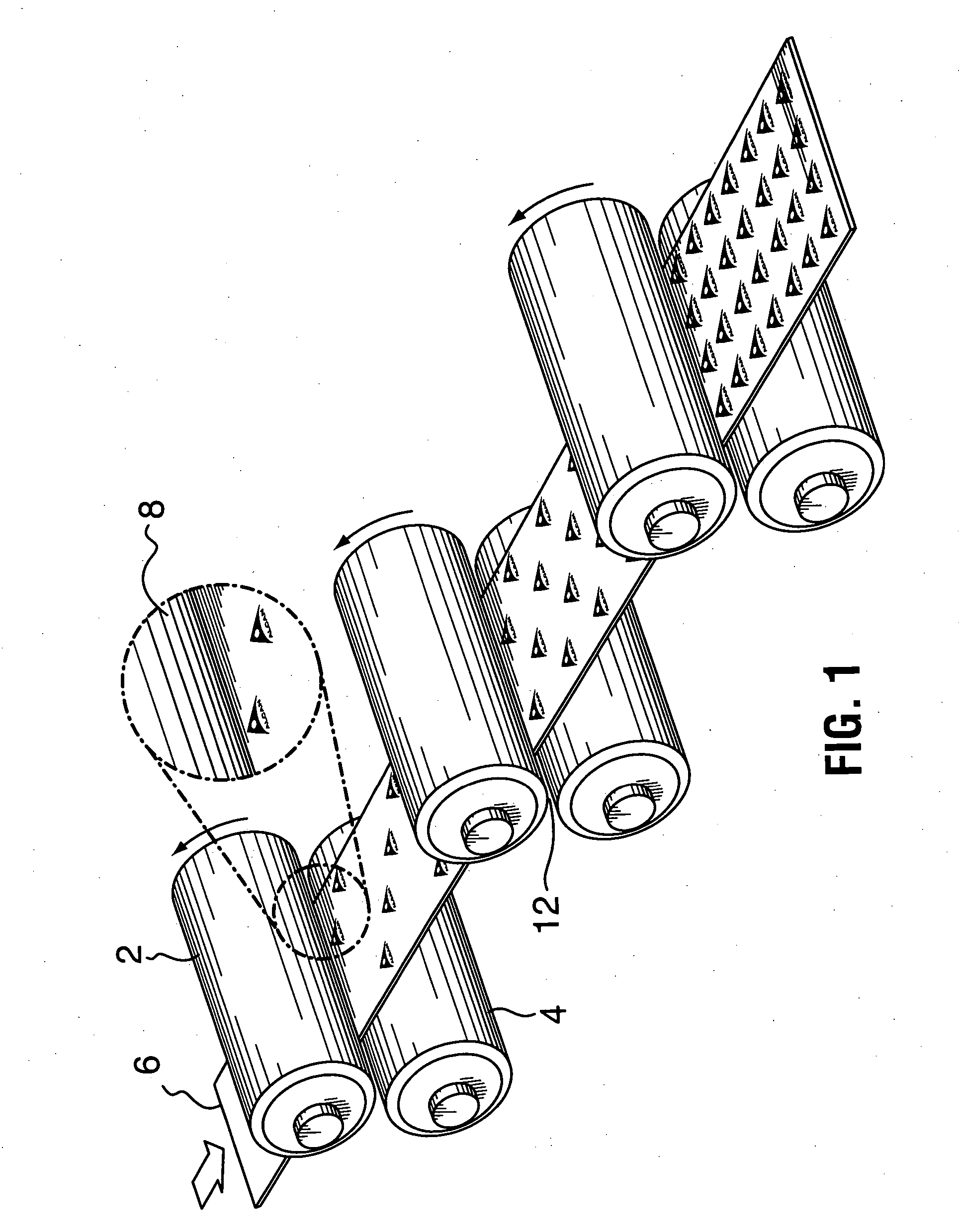Roll embossing of discrete features
a discrete feature and embossing technology, applied in the field of rolling embossing, can solve the problems of plastic deformation throughout the sheet, wrinkling or buckling, and problems in handling and quality
- Summary
- Abstract
- Description
- Claims
- Application Information
AI Technical Summary
Benefits of technology
Problems solved by technology
Method used
Image
Examples
first embodiment
[0028] the present invention is shown in FIG. 2. In this embodiment, a surface of the work roll 2 is selectively back polished in regions 7 between localized patterning features 8 of interest (only one patterning feature 8 is shown in FIG. 2, but several such features could be incorporated on the surface of a single work roll). In this way, the patterning features 8 are left displaced from the remaining cylindrical part of the work roll 2, creating a localized surface region in the form of a plateau feature 10. Material from the surface of the work roll 2 can alternatively be removed by any other well know means such as, for example abrasion, grinding, etching or plasma or spark erosion of the roll surface in between the features of interest.
[0029] As the plateau feature 10 enters the roll-bite, its height relative to the remaining surface of the work roll 2 reduces the roll-gap 12 between the work roll 2 and the counter roll 4. The space 14 created by the reduced roll-gap 12 has th...
third embodiment
[0035] the present invention is shown in FIG. 4, which produces improved sheet article strip having conventional macroscopic embossed features imprinted thereon, but also having a fine scale microscopic pattern imprinted on the macroscopic feature. As seen in FIG. 4, one of the pair of rolls has a projection 16 projecting from its surface and the other of the pair of rolls has a recess 18 extending into its surface. The projection 16 and recess 18 are macroscopic in area and depth. The projection 16 and the recess 18 are shaped and dimensioned so that said projection 16 extends across the roll gap 12 into the recess 18 when the pair of rolls are rotated to bring the projection 16 and recess 18 into alignment. When aligned, the projection 16 and the recess 18 have confronting ends 20. Such rolls are well known in the art and are conventionally used to create macroscopic embossing features on rolled strip metal.
[0036] In this embodiment of the present invention a patterning feature 8 ...
fourth embodiment
[0037] In a fourth embodiment as shown in FIG. 5, similar or different patterning features 8 can be applied to the work roll 2 and the counter roll 4, whereby one or both of the rolls have plateau features 10, to align with each of the patterning features 8, thereby allowing for similar or different patterns to be applied to both surfaces of the sheet article 6.
[0038] In all of the embodiments described above, the thickness and mechanical properties of the sheet article substrate, as well as the nature of pattern to be imprinted will determine how much narrower the space 14 should be than the roll gap 12. As well, the concentration of localized patterns on the roll surface (percentage of the area of the sheet article to be imprinted) will depend upon such factors as the gauge and temper of the metal to be imprinted, the original topography of the sheet metal and the nature of pattern to be imprinted.
[0039] In all of the embodiments described above, the roll gap 12, corresponding to...
PUM
| Property | Measurement | Unit |
|---|---|---|
| diameter | aaaaa | aaaaa |
| pressure | aaaaa | aaaaa |
| elastic yield strength | aaaaa | aaaaa |
Abstract
Description
Claims
Application Information
 Login to View More
Login to View More - R&D
- Intellectual Property
- Life Sciences
- Materials
- Tech Scout
- Unparalleled Data Quality
- Higher Quality Content
- 60% Fewer Hallucinations
Browse by: Latest US Patents, China's latest patents, Technical Efficacy Thesaurus, Application Domain, Technology Topic, Popular Technical Reports.
© 2025 PatSnap. All rights reserved.Legal|Privacy policy|Modern Slavery Act Transparency Statement|Sitemap|About US| Contact US: help@patsnap.com



